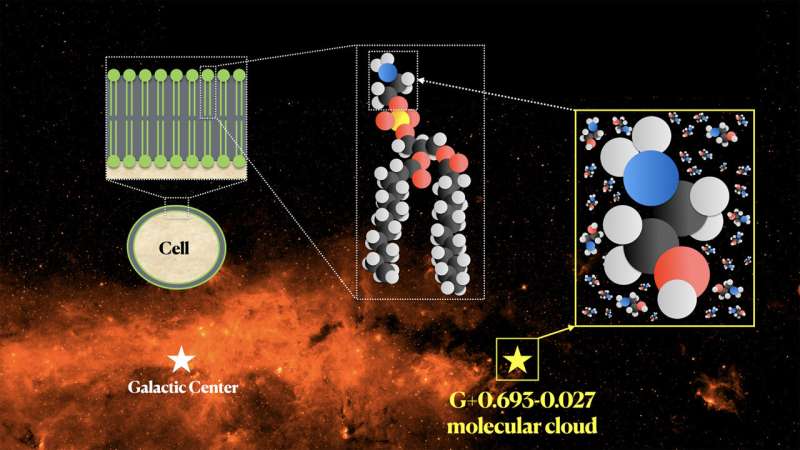May 25, 2021 report
Prebiotic ethanolamine found in a molecular cloud near the center of the Milky Way

An international team of researchers has found evidence of prebiotic ethanolamine (NH2CH2CH2OH) in a molecular cloud near the center of the Milky Way galaxy. In their paper published in Proceedings of the National Academy of Sciences, the group describes their study of the amino alcohol and why they believe it could have contributed to the development of life on earth.
Despite much research, scientists still cannot explain how life came to exist on Earth. One area of study involves the initial formation of cellular membranes—an important evolutionary step. Cellular membranes are dual-layered barriers of cells that serve to keep the contents of cells inside of an enclosed packet. They also serve as a gatekeeper, allowing some chemicals in and keeping others out. The lipids that make up the barrier are known as phospholipids, and one of them, ethanolamine, is a component of the head of phospholipids. The heads of phospholipids are the parts of the cells that make up the inner and outer parts of the barrier.
Prior research has shown that under the right conditions (such as in hydrothermal vents in the oceans), ethanolamine can help form amino acids, which are the building blocks of proteins. Prior research has also found ethanolamine in meteorites, which suggests a possible origin. In this new effort, the researchers have found evidence that suggests ethanolamine likely formed in deep space and then made its way into meteorites and other small bodies in the solar system—one of which could have been a precursor to planet Earth. The researchers came to this conclusion after studying a dense cloud of dust near the center of the galaxy. Data from the Yerkes and IRAM telescopes showed that one of the ingredients of the cloud was ethanolamine. Further study suggested that slow collisions between bits of dust and gas had incited reactions that led to the formation of a host of materials including combinations of hydrogen, nitrogen and carbon, one of which was ethanolamine. The researchers suggest their findings hint at the likelihood of the building blocks of life on earth, coming from places all over the galaxy.
More information: Víctor M. Rivilla et al, Discovery in space of ethanolamine, the simplest phospholipid head group, Proceedings of the National Academy of Sciences (2021). DOI: 10.1073/pnas.2101314118
Journal information: Proceedings of the National Academy of Sciences
© 2021 Science X Network





















